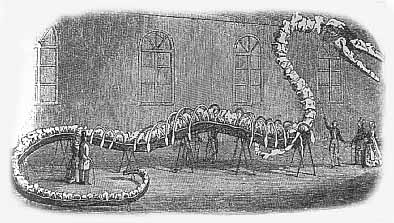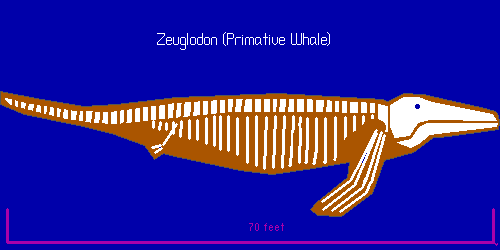pop up description layer
HOME
Cryptozoology UFO Mysteries Aviation Space & Time Dinosaurs Geology Archaeology Exploration 7 Wonders Surprising Science Troubled History Library Laboratory Attic Theater Store Index/Site Map Cyclorama
Search the Site: |
|
x
The Zeuglodon
It looked like a sea serpent. It swam like a sea serpent. Its original name, Basilosaurus, even meant King of Reptiles. But was the Zeuglodon, an aquatic animal that apparently lived from 37 to 53 million years ago, a sea serpent? In 1845 Albert Koch, owner of a small museum in St. Louis, set out to visit Alabama. He heard rumors that people were finding the bones of sea serpents in the ground. Koch was no stranger to paleontology. He had already dug up the bones of a giant mastodon and took it on a tour of America. Koch, more a huckster than a serious scientist, had added an extra ten vertebrae from another skeleton and wooden blocks to make the creature look even more gigantic than it really was. In 1842 he sold it to The British Museum, who shrunk the creature back to normal size before putting it on display. Arriving in Alabama, Koch found these "sea serpent" vertebrae so common that people were using them for furniture. Finding a full skeleton was more difficult, and it took him months to discover a nearly complete set of bones near the Sintabogure River. It took three more months of hard work to excavate the bones and pack them into five wagonloads. These Koch, using his old tricks, assembled into a skeleton 114 feet long using the vertebrae of five different animals. Koch took his creation on tour. In New York the newspaper The New York Disector reviewed the exhibit: "The serpent of the Deucalion deluge, slain by Apollo Pythius, is beheld with scarcely the aid of the dullest fancy." The creature was christened Hydroargos sillimani by Koch, which meant "Silliman's Master-of-the-Seas." Benjamin Silliman, a professor at Yale University, had been open to the possibility that sea serpents might exist after some sightings in New England in 1827. Silliman, not wishing to be associated with Koch's creation, however, demanded the name be changed and Koch complied. Koch would eventually take his monster to Europe, sell it, return to Alabama, excavate another and take it on tour also. But was what he was showing really an exaggerated sea serpent?
A few years before in 1832, a box arrived at the American Philosophical Society in Philadelphia. In it was a lump of rock and a letter from one Judge Bry of Louisiana. The lump was the fossil of what Bry believed might be a sea monster. The fossil was given to Dr. Richard Harlan, a surgeon and paleontologist, to examine. He thought it might have come from a sea going-lizard. More bones from the same type of creature arrived from Alabama including a jaw. The jaw was hollow which seemed to support Harlan's reptile theory, so the creature was christened the Basilosaurus which meant King of Reptiles making it a true "sea serpent." Harlan did this even though the creature had teeth that were narrow toward the front of the jaw, but larger toward the back, normally characteristic of a mammal. In 1839 Harlan traveled to London to address a meeting of the Geographic Society. When he arrived he was plunged into a controversy between scientists who believed that mammals lived during the Mesozoic Period and those that didn't. Even though the Basilosaurus was from the following period, the Eocene, it might prove that some non-identical teeth, found in Mesozoic jaws, could belong to a form of reptile, instead of mammals. In London the great English anatomist, Richard Owen (who coined the term dinosaur a few years later), got a hold of Harlan's fossils and began a close examination. He noted that the hollow jaw was not just characteristic of reptiles, but was found on the sperm whale, too. He also discovered that the shape of the spinal cord channel in the vertebrae was like that of a whale's, not a reptile. Finally by splitting open some of the teeth, Owen showed that they were more like a marine mammal than that of a marine lizard. Harlan had to agree and the Basilosaurus ceased to be a sea serpent, but was instead reclassified as a primitive form of whale. Skeletons of the Zeuglodon have been found across North America and in parts of Africa. In life the creatures ranged from fifty-five to seventy-five feet long and sometimes had skull a five feet in length. It has the remains of hind leg bones suggesting that the animal's ancestors once lived on the land (Scientists believe that all whales came from a four footed hyena-like creature known as a Mesonychid). There has been speculation that the Zeuglodon is not dead, but inhabiting cold water lakes like Loch Ness and Lake Champlain as their famous monsters. While this seems unlikely, it is not at all impossible, since the Coelacanth, a primitive fish thought to be extinct for 65 million years, showed up off the coast of South Africa in 1938. The Zeuglodon is the official state fossil of Alabama and is protected by law. So if you find one on your next visit to that southern state, make sure you call the governor and ask permission before you take him home with you. Copyright Lee Krystek,1996, 1998. All Rights Reserved |
|
Related Links |
|
|






